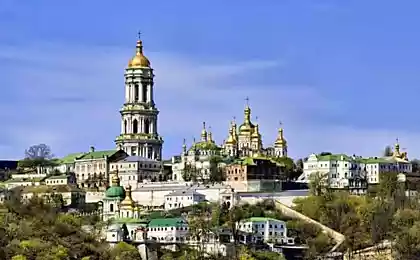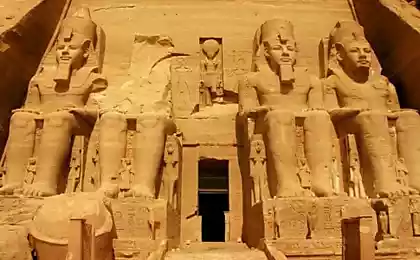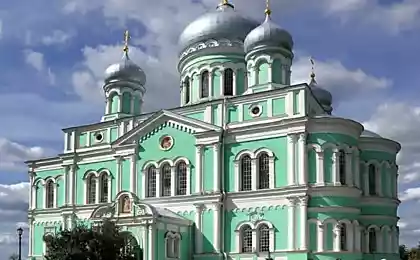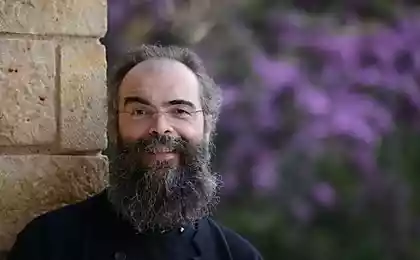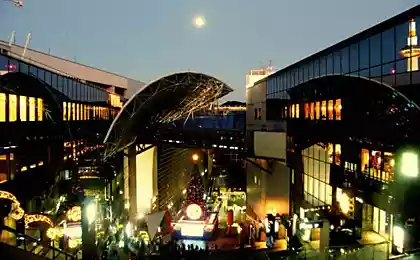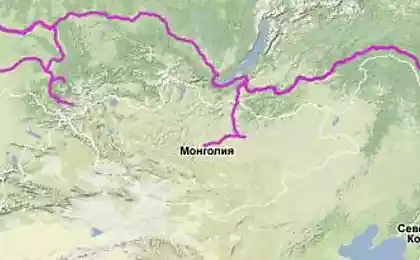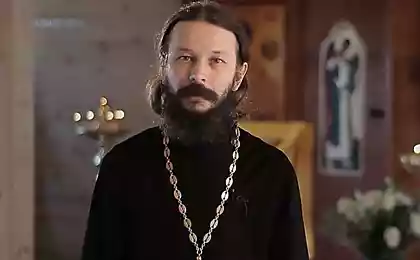1003
Closer to God. Ten mountain monasteries
Mountains before any other place on Earth, touch the sky. Here different colors, different smells and sounds. Here, you do not think - feel - how fleeting life is often shallow, worthless our earthly cares and worries. The sky here looks different: not as a tent, spread out over our heads, but as the depth, permeates this world. Passion, excitement, memories dissolve themselves, and you feel that you should want to, and you're flying, up, up even higher - if not the body, the soul. The sun warms your frozen hands, and at night the stars are with you talk about the most intimate. Mountain source any sweeter wines - you drink from it and krepnesh body and spirit. Every sound is uttered barely audible, loud and clear sounds in the shower. People come here to seekers of divine beauty, here come the monks to get rid of passions, to take the world and ourselves in it, to feel the taste of each word of prayer, and to merge with the spirit of pure light.
42 photos + text
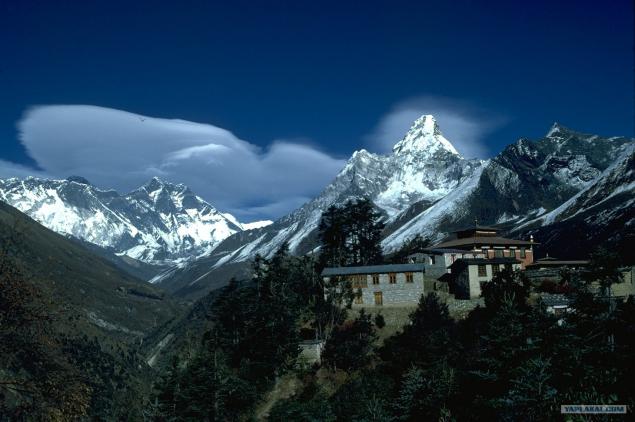
Meteora
The tops of these rocks hermits have chosen long before the 10th century. They slept in caves and prayer laid site itself, which is called - "a place of prayer».
From time to time hermits gathered for joint worship, as in Christianity, there are kinds of ordinances that hold alone or difficult, or impossible. To this end, they walked down the church, located in the cities of Thessaly (a historical region of Greece where, in particular, according to legend, was born Achilles), or in the monastery at the foot of the cliffs.
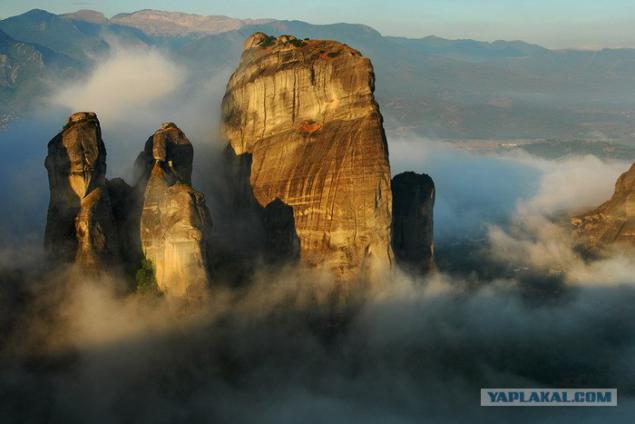
In the 13th century, after the capture of Thessaly by the Turks, to descend into the city has become dangerous. Gradually the mountain hermits began to coalesce in the mountain communities. One of them consisted of 14 people. Led by a monk Athanasius (a refugee from Mount Athos), they settled on a pillar Stag (Capel), height of 613 meters above sea level and 413 meters above the town of Kalambaka, engaged in construction, started monastic laws, which the monks in general adhere to so far, and They called her and about a thousand local rocks "Meteor", which means "floating in the air."

Today the monastery is not one of them here a few. The richest of them - the great monastery of St. Stephen, to get to that before it was easier than to other monasteries, today it is transformed into a female. In general, to get to the monasteries of Meteora in the early decades of the last century was not easy: the rickety stairs tridtsatimetrovoy resettable, a rope, or a rope net. These nets are still often used to supply the monasteries, but almost immediately after the Second World War, there was built-serpatin road - no highway, but you can get close. And so on - for suspended bridges, thrown over a precipice.
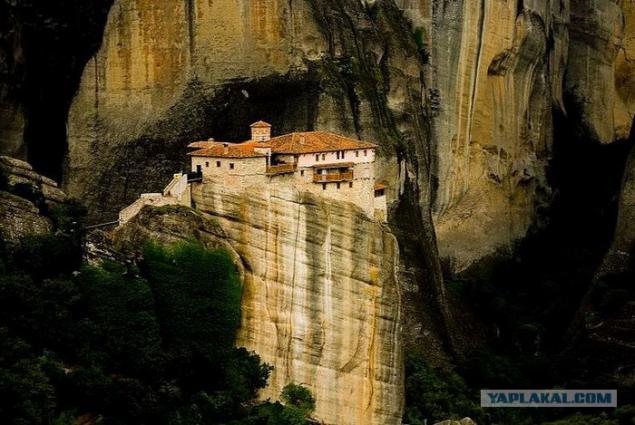
That is why today the ascetic way of local life from time to time disturbed invasion vain, worldly. And because this hermit in polumonastyryah - polumuzeyah do nothing. We must look for new places. Apparently, because of the twenty-four monasteries of Meteora today operates only six.
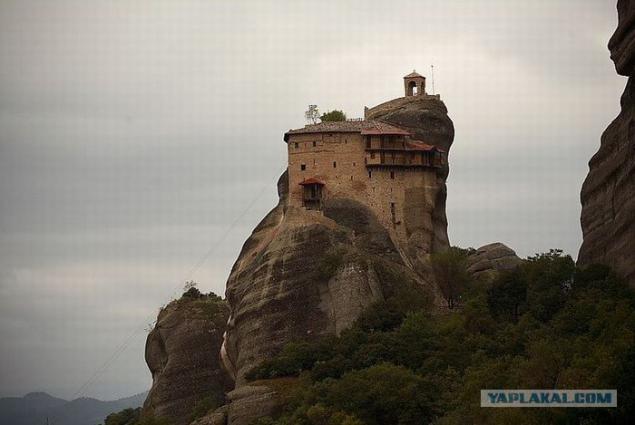
Rongbuk
At the foot of the Rongbuk glacier at an altitude of 5100m above sea level - only 200 meters lower than the northern base camp on the slopes of Mount Everest - is the world's highest monastery. Hikers who want to climb Everest from the northern side, be sure to pass through the Rongbuk with panoramic views of the peaks of Shishapangma, Everest, Cho Oyu and Gyachung-Kahn.

Like the monasteries of Meteora, this monastery was founded not on an empty place. For four centuries, the monks and hermits put here huts, where it was to rest between meditations. On the walls of caves located in the vicinity of the point of meditation - above, below and in the valley - can be seen carved words of the prayers, poems and sacred signs.

The monastery in 1902 was founded by Lama Tibetan Nyingma school, which is characterized in that it contains elements of shamanism. Today it lives according to various estimates whether thirty monks and nuns, thirty, or twenty monks and nuns ten. To check this, you need to get up here. Today it can be done by car, which is just three hours from the valley lift travel from the Friendship Highway to the monastery.

From ancient times to the present day monastery is very actively visited students and pilgrims, including Nepal and Mongolia, held here and special Buddhist ceremony at the monastery was destroyed twice - in 1974 and 1989. After the last fire is now under reconstruction, updated painting, functioning monastery premises and the guest house, even a small, but cozy restaurant.
The monks are not very pleased that the spirit of mountain climbers are concerned, but always ready to help them, and they pray for the souls of sinners.
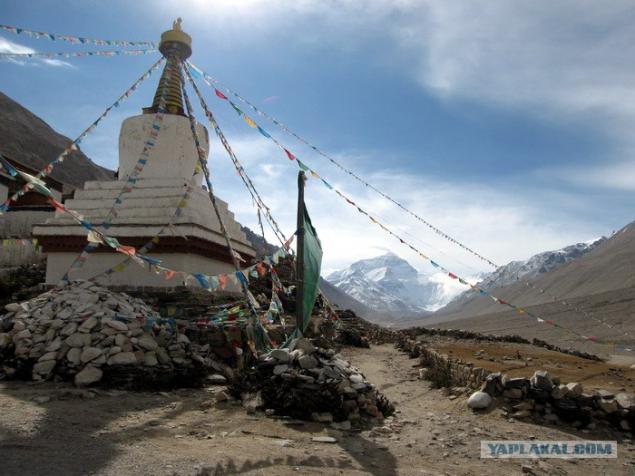
Sigiriya
In the mid 19th century Ceylon English hunter on top of the 200-meter mountain discovered the ruins of a stone building. No one knew exactly what it was for the structure, but travelers in those years was told that with my own eyes have seen preserved marble fountain, surrounded by gardens and ponds and lined with jewels. According to tradition and heritage of India - The Taj Mahal Palace, too, was almost entirely paved with a myriad of gemstones that are measured otkolupyvali evil British and taken to his home. True or not - no one knows the photos are not kept, but the idea is beautiful.

Another tradition of "open" us the story of the legendary Sigiriya Kassapa, the eldest son of the king, the father deprived of power, believes it rightfully, angry and killed unfair ancestor, and took power into their own hands. And he built a new capital, the palace-fortress on the hill resembles a sleeping lion - the symbol of Ceylon, where he lived happily ever after, good profiteers and enemies are not afraid. It was built a long time - as much as 18 years. By the way, the same number - eighteen - remains to this day and the ancient frescoes, which, presumably, was originally almost half a millennium. When India came back from the war younger brother Kassapa, who wrote to his father's throne, Kassapa decided to fight him. The army did not support him, and Kassapa cut his throat, and his brother destroyed the citadel and returned to the capital of the old place. This version now official languages.
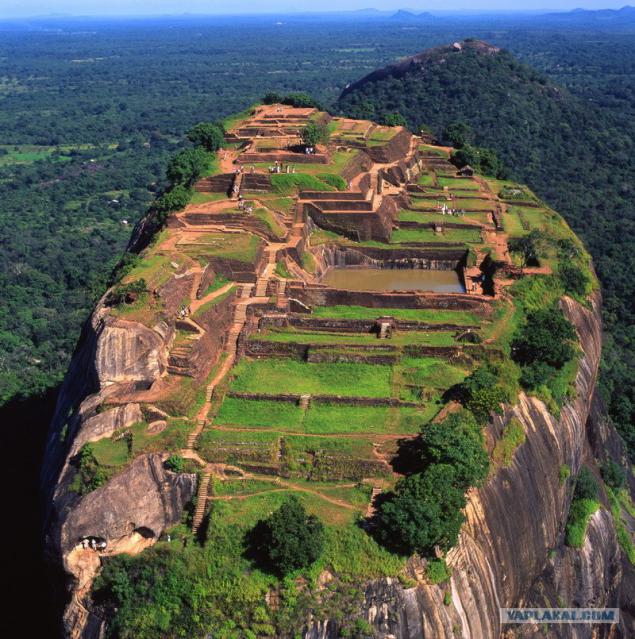
Alas, it does not answer the question: where is the palace were rooms, bedrooms, toilets? Why in the palace, the central part of which is a rectangular platform the size of 13h7 m, there is no sign remains of the roof - and this in a region where 8 months in a year dominated by the wind and the monsoon rains?
Archaeologists claim that in the 2nd century AD there was a monastery on the territory of which to this day remains of cave temples with the remains of paintings and inscriptions of a religious nature. Most likely, he lived in it the monks were followers of the teachings of the Mahayana, in which the Buddha of the perfect man (so he thought the older flow of Buddhism) has become a supernatural being, except monk mahayanets could come to the monastery for a couple of years and then return in the world - this is perfect for non-standard orthodox Buddhists.
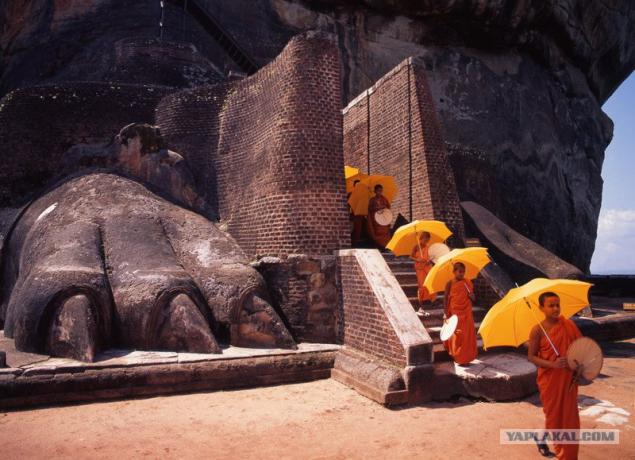
Kassapa supported monastery political and financial way, of course, has been here, but lived in the capital, which has remained in the same place as that of his father. Troubles in the description of his life and work, namely chronicle Mahavamsa, apparently, the authors made-chroniclers, who were orthodox adherents of Buddhism, which is understandable.
This version is the fact that at the time of Kassapa Temple of Tooth Relic remained in place - in the old capital, moreover, Kassapa built it several significant temples, and most likely, it is lived, sometimes bumping into Sigiriya.
Also as part of the version to fit the image on the Sigiriya frescoes of the goddess Tara, the mother of all Bud, one of the most revered those who profess the Mahayana.
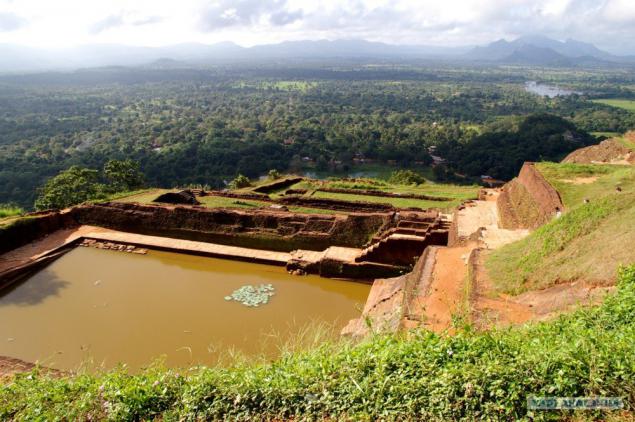
Goreme
At an altitude of 1000 meters above sea level on the Anatolian plateau in Turkey is Cappadocia. Volcanic eruptions that happened here millions of years ago, have turned this place into a fabulous landscape: bizarre mountains, rolling valleys, rocks unusual shapes. The rocks are soft, so the man was not difficult to build himself a home inside the rocks. Once these structures have lived Simon George, Basil the Great, Gregory the Theologian - Christian saints. Province Cappadocia area of approximately 300 square kilometers, called the Göreme National Park, is a true open-air museum.
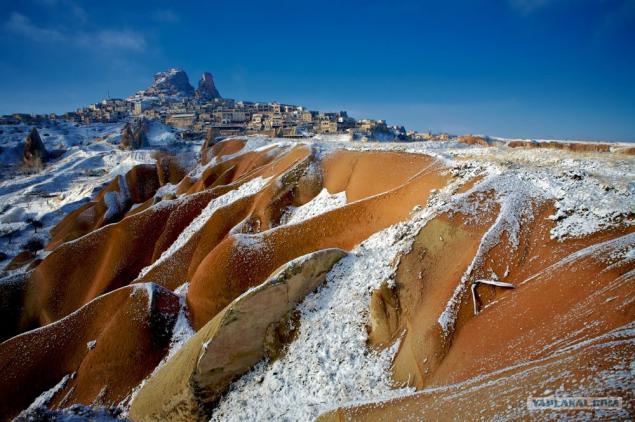
It is not always clear, in honor of the holiday it was consecrated the altars of local churches, as their vernacular names usually reflect only the outer detail structures. The "Snake Temple" Gregory Theodore the Victorious with spears hit the big snake in the "Temple with sandals," You can see the two recesses in the form of human feet located at the entrance to the "Temple of the Dark" twilight reigns - there is only one tiny window.
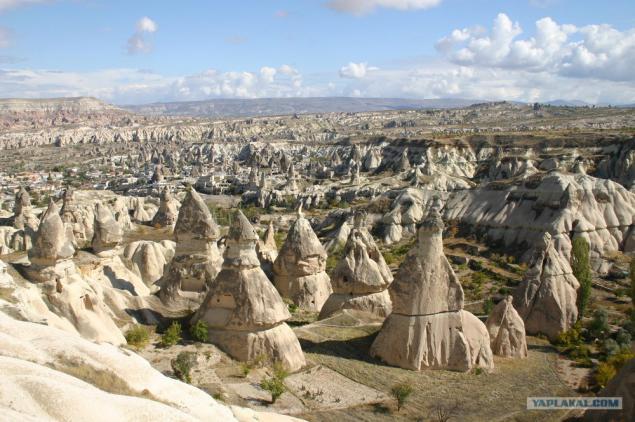
Goreme - the largest monastery complex Cappadocia, where in the early centuries of Christianity, the faithful have fled from Jerusalem and elsewhere, fleeing from the persecution of the authorities. It is from these places there Forty Martyrs of Sebaste, hristan, martyred for their faith in Christ in Sebastia - this part of the territory of the former Little Armenia today belongs to Turkey.
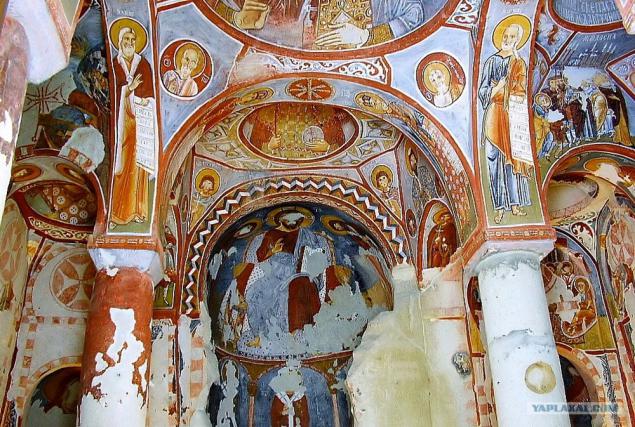
To force them to offer sacrifice to the pagan gods, and thus renounce Christ, Roman general Agricola put them in an icy lake. I had a chance to break the otgretsya bath, set on the shore of the lake. I could not resist just one Cappadocian, but he died as soon as they ran into the bath. One of the Roman soldiers, struck by the power of faith, the martyrs joined the Christians, they again became forty, and they all died.
Today in Goreme 10 churches and chapels built in the years 900-1200 in the Byzantine style, and decorated in a unique Cappadocian.

Taksang-Lhakhang
In the eighth century, Guru Rinpoche three visits to Bhutan. The third time he came to Bhutan in the Taksang a tigress, which has become his wife, and blessed him as the second Kailash. In order to subdue the evil spirits of those places, Rinpoche took the form of terrible Drollo George - one of his eight emanations - Bhutanese Taksang and sanctified as a place for the protection of the drachma, ie intangible particles that form the basis of life.
"Taksang" is translated as "Tiger's Lair" and it was one of the thirteen sacred caves, which in Tibet and Bhutan carried out meditation. Rinpoche spent in the cave Taksang four months, and not only tamed the angry mantras evil spirits, but also filled the cave with their deep inner thoughts.
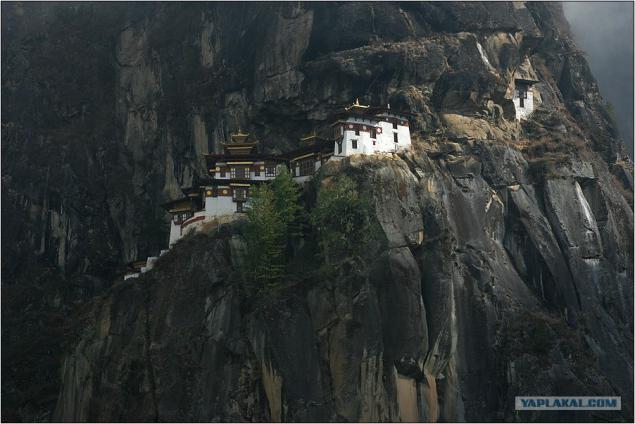
The first small temple was placed here in the 13th century, and today the monastery complex consists of 10 Gompa ie temples for spiritual training and meditation, and is also located on the most sacred cave.
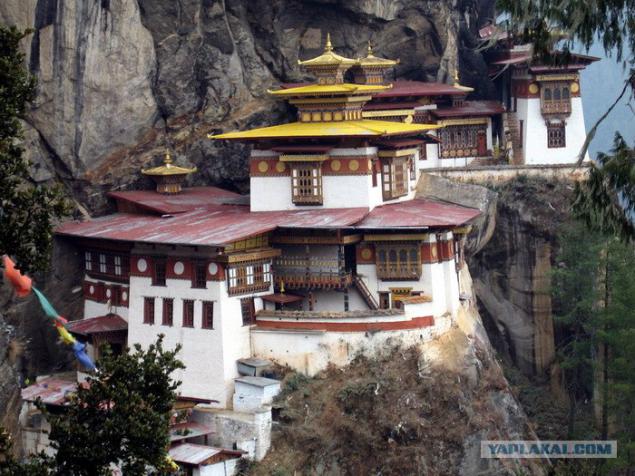
The monastery is located on a cliff height of 3120 m, 700 m above the valley of Paro. This place is holy, full of drachmas, thoughts and emotions of the great Buddhists like Milarepa or Shadbrung who managed to Bhutanese culture separate from the Tibetan and actually considered the founder of Bhutan, as a state. In 1998 the monastery was almost completely burned down, but the next day had come here on foot King of Bhutan - because no other way to get here - to find out what kind of assistance is needed.
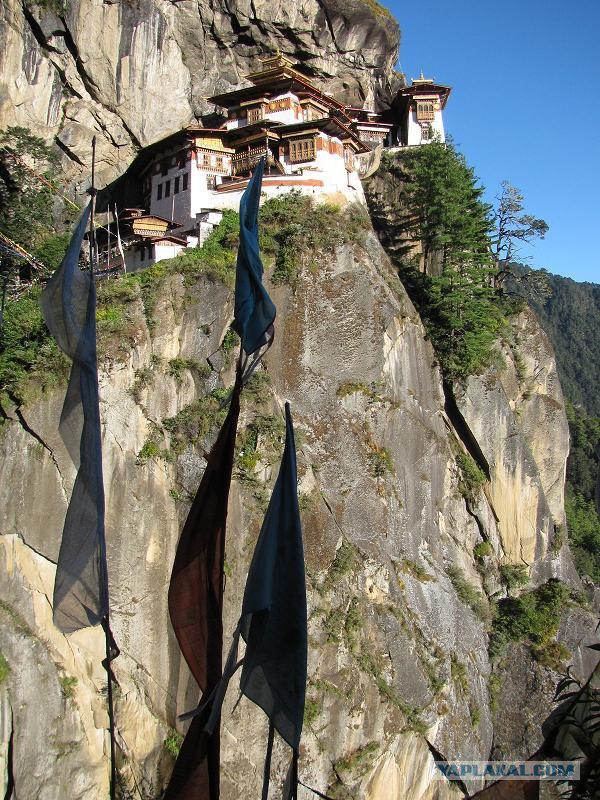
Emei Shan
Emei Shan - one of the four most sacred Buddhist mountains of China. It was built by an incredible number of monasteries and temples, like the Buddhist and Tao, who lived in the world of harmony for centuries. During the Cultural Revolution have caused serious damage to the monastic brotherhood, and today there are only twenty churches, most of which are in poor condition.

Bodhistattvoy (ie being who fell into the path of becoming a Buddha) of this area is considered to Samantabhadra, the legendary companion of the historical Buddha, who is portrayed riding a three-headed white elephant with a lotus flower in her hand. He flew on his white elephant Samantabhadra Emeya it from the top, and because the mountain Emei Shan became a place of his eternal residence. And pulled Buddhist pilgrims here, and began to climb the Emei Chinese emperors, performing rites of worship heaven and earth, to life in China has a long and happy.
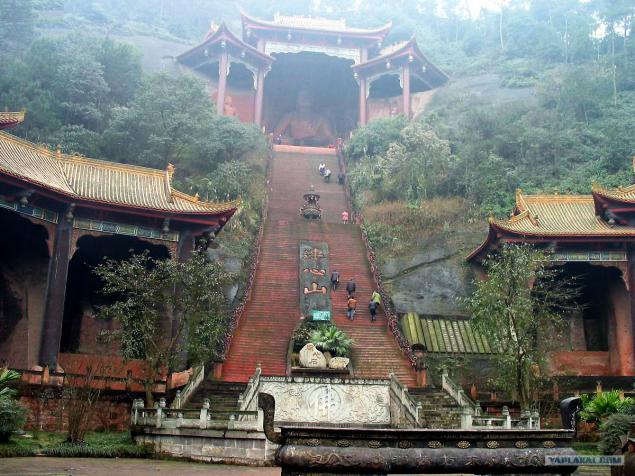
On top Emeya, at an altitude of 3077 m is a beautifully restored "Temple of Ten Thousand Years"), built here in the first century, and rebuilt in the ninth. For centuries, Buddhists made here pilgrimage and Pilgrim was not close to about fifty kilometers to go it was to be, in particular, by necessarily by the world's largest stone Buddha statue (71 meters), set back in the 719 - 803 years near the town of Leshan in 30 km from Emeya. Today, tourists climb to an altitude of 2500 m bus, and further lift. But whoever who has the time not only in the shops and restaurants who want to experience the beauty of the place, still climbs up the mountain on foot.

Local forests are still full of monkeys. Watching them, the monks from various temples came up with their fighting styles, a lot of them, but they are all united under the name School of Emei Wushu. But the monk-warrior is now difficult to see here, but it is still several times a year then you can see the "aura of the Buddha" - an optical phenomenon.
First, there is the rainbow around the sun crown, and then a man looking at her side suddenly begins to "see" the Buddha, taking him his own shadow with a halo around his head. They say that in the past, pilgrims, not even familiar with the concept of "optics", believed that the Buddha calls them to follow him and jumped down the steep slope.

Syuankunsy the gorge Heng Shan
From the summit of the highest peak of the array Heng Shan overlook that gives the impression as if you have reached heaven. On the half way to the top is a pavilion on which is written: "persevere in the path until you half way. Fulfilling your cherished aspirations close, but you need to accept the challenge of the mountains to reach their summits. " According to the theory of five elements of Tao, of which the all - metal, wood, water, fire and earth - and meet the five areas on which there are five sacred mountains, one of which Heng Shan.
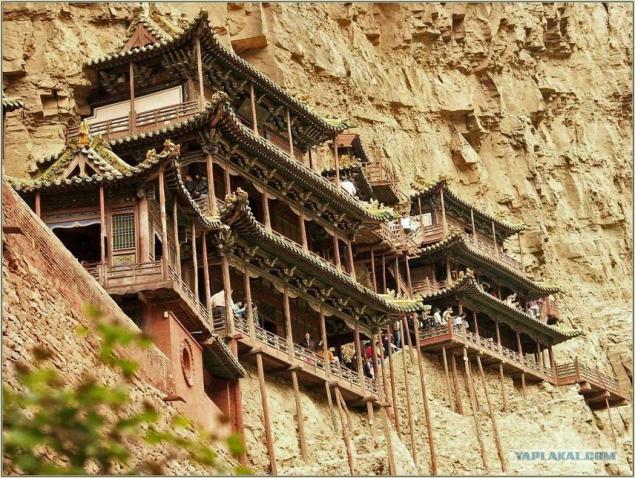
But not only Taoists revere the mountain - in the monastery can be seen next to the sculpture of Sakyamuni (Buddha), Confucius and Laozi: here peacefully coexist just three religions - Buddhism, Taoism and Confucianism. At the foot of Mount Hengshan is a temple area of 9800 sq Nanyu. m. Eight Taoist temples on the east side are arranged symmetrically with eight Buddhist temples on the west, which symbolizes the equality of the two religions.
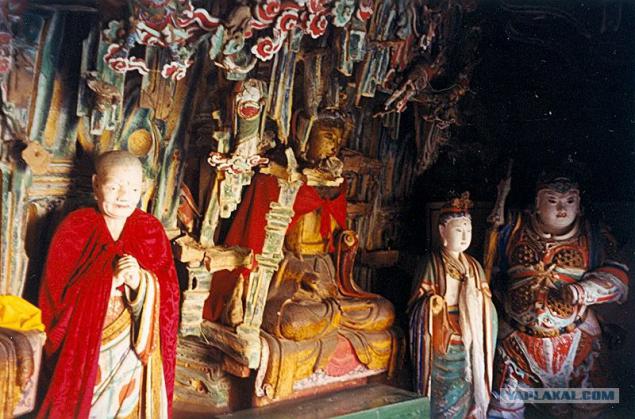
In the gorge Henshanskih mountains is the famous "hanging" monastery Hanging Temple, attached to the mountain just a few pillars. Since its construction, the year 491, it was rebuilt several times, rebuilt, and finally restored. The last major repair was held here in 1900. Therefore, not all of the 40 rooms and halls of the monastery are in good condition. Buildings are interconnected system of corridors, walkways and bridges.
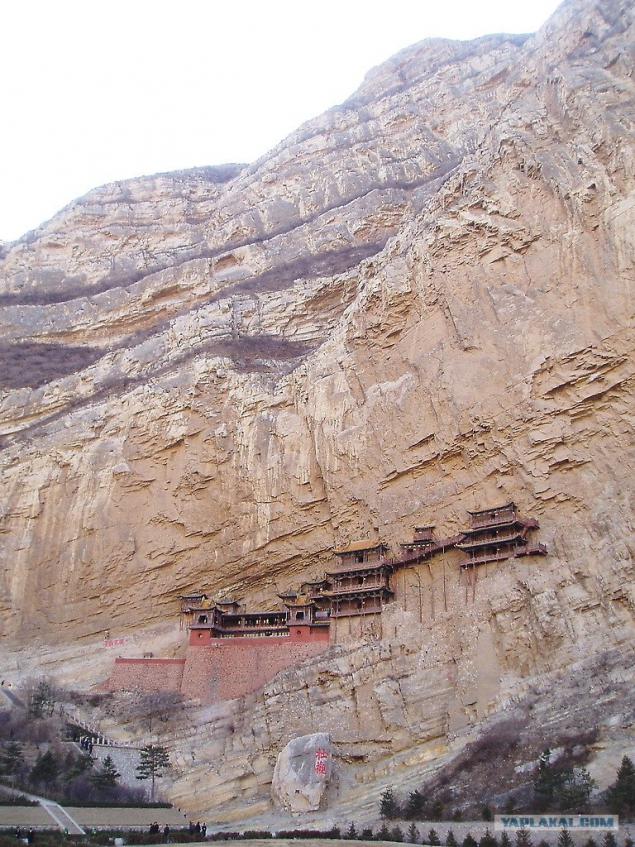
On the mountain Hen Shan was a cave improving the great deity of time Tai Sui, which is also called the Grand Duke, the Grand Duke and Grand Duke Jupiter, which counteract the like and seek his protection - a direct path to disaster. And follow the instructions of the Grand Duke in the everyday bustle is very difficult, "Do not be thinking and not make an effort - the first step to understanding the Tao. Do not go anywhere or do anything - the first step towards the attainment of peace in the Tao. Do not have a point of reference and does not follow any path - the first step towards the attainment of the Tao. " And because the most popular Taoist amulet - talisman that protects from the wrath of Tai Sui.
Hen Shan - a symbol of longevity, so revered in China, since it was one of the goals of perfection, so there is room for improvement has been vast. Until now, there may be something here and there to stumble upon the inscriptions on the stones, freestanding sculptures or stelae. Urban residents often come here in the summer for the weekend just to take a walk and relax, and in the fall - to see if it was true wild geese, which in China symbolizes yang, masculine, light, holy spirit linger here long before his long-distance flights.

Sumela
The modern Turkish town of Trabzon in time when the Empire of Trebizond Trebizond Greeks call, as it is still called, and Orthodox Christians. Not far from Trebizond since the time of the Byzantine Empire preserved rock monastery of the Blessed Virgin or Sumela (accent on the last letter), which means "on the hill Melas."
Love.
Source:
42 photos + text

Meteora
The tops of these rocks hermits have chosen long before the 10th century. They slept in caves and prayer laid site itself, which is called - "a place of prayer».
From time to time hermits gathered for joint worship, as in Christianity, there are kinds of ordinances that hold alone or difficult, or impossible. To this end, they walked down the church, located in the cities of Thessaly (a historical region of Greece where, in particular, according to legend, was born Achilles), or in the monastery at the foot of the cliffs.

In the 13th century, after the capture of Thessaly by the Turks, to descend into the city has become dangerous. Gradually the mountain hermits began to coalesce in the mountain communities. One of them consisted of 14 people. Led by a monk Athanasius (a refugee from Mount Athos), they settled on a pillar Stag (Capel), height of 613 meters above sea level and 413 meters above the town of Kalambaka, engaged in construction, started monastic laws, which the monks in general adhere to so far, and They called her and about a thousand local rocks "Meteor", which means "floating in the air."

Today the monastery is not one of them here a few. The richest of them - the great monastery of St. Stephen, to get to that before it was easier than to other monasteries, today it is transformed into a female. In general, to get to the monasteries of Meteora in the early decades of the last century was not easy: the rickety stairs tridtsatimetrovoy resettable, a rope, or a rope net. These nets are still often used to supply the monasteries, but almost immediately after the Second World War, there was built-serpatin road - no highway, but you can get close. And so on - for suspended bridges, thrown over a precipice.

That is why today the ascetic way of local life from time to time disturbed invasion vain, worldly. And because this hermit in polumonastyryah - polumuzeyah do nothing. We must look for new places. Apparently, because of the twenty-four monasteries of Meteora today operates only six.

Rongbuk
At the foot of the Rongbuk glacier at an altitude of 5100m above sea level - only 200 meters lower than the northern base camp on the slopes of Mount Everest - is the world's highest monastery. Hikers who want to climb Everest from the northern side, be sure to pass through the Rongbuk with panoramic views of the peaks of Shishapangma, Everest, Cho Oyu and Gyachung-Kahn.

Like the monasteries of Meteora, this monastery was founded not on an empty place. For four centuries, the monks and hermits put here huts, where it was to rest between meditations. On the walls of caves located in the vicinity of the point of meditation - above, below and in the valley - can be seen carved words of the prayers, poems and sacred signs.

The monastery in 1902 was founded by Lama Tibetan Nyingma school, which is characterized in that it contains elements of shamanism. Today it lives according to various estimates whether thirty monks and nuns, thirty, or twenty monks and nuns ten. To check this, you need to get up here. Today it can be done by car, which is just three hours from the valley lift travel from the Friendship Highway to the monastery.

From ancient times to the present day monastery is very actively visited students and pilgrims, including Nepal and Mongolia, held here and special Buddhist ceremony at the monastery was destroyed twice - in 1974 and 1989. After the last fire is now under reconstruction, updated painting, functioning monastery premises and the guest house, even a small, but cozy restaurant.
The monks are not very pleased that the spirit of mountain climbers are concerned, but always ready to help them, and they pray for the souls of sinners.

Sigiriya
In the mid 19th century Ceylon English hunter on top of the 200-meter mountain discovered the ruins of a stone building. No one knew exactly what it was for the structure, but travelers in those years was told that with my own eyes have seen preserved marble fountain, surrounded by gardens and ponds and lined with jewels. According to tradition and heritage of India - The Taj Mahal Palace, too, was almost entirely paved with a myriad of gemstones that are measured otkolupyvali evil British and taken to his home. True or not - no one knows the photos are not kept, but the idea is beautiful.

Another tradition of "open" us the story of the legendary Sigiriya Kassapa, the eldest son of the king, the father deprived of power, believes it rightfully, angry and killed unfair ancestor, and took power into their own hands. And he built a new capital, the palace-fortress on the hill resembles a sleeping lion - the symbol of Ceylon, where he lived happily ever after, good profiteers and enemies are not afraid. It was built a long time - as much as 18 years. By the way, the same number - eighteen - remains to this day and the ancient frescoes, which, presumably, was originally almost half a millennium. When India came back from the war younger brother Kassapa, who wrote to his father's throne, Kassapa decided to fight him. The army did not support him, and Kassapa cut his throat, and his brother destroyed the citadel and returned to the capital of the old place. This version now official languages.

Alas, it does not answer the question: where is the palace were rooms, bedrooms, toilets? Why in the palace, the central part of which is a rectangular platform the size of 13h7 m, there is no sign remains of the roof - and this in a region where 8 months in a year dominated by the wind and the monsoon rains?
Archaeologists claim that in the 2nd century AD there was a monastery on the territory of which to this day remains of cave temples with the remains of paintings and inscriptions of a religious nature. Most likely, he lived in it the monks were followers of the teachings of the Mahayana, in which the Buddha of the perfect man (so he thought the older flow of Buddhism) has become a supernatural being, except monk mahayanets could come to the monastery for a couple of years and then return in the world - this is perfect for non-standard orthodox Buddhists.

Kassapa supported monastery political and financial way, of course, has been here, but lived in the capital, which has remained in the same place as that of his father. Troubles in the description of his life and work, namely chronicle Mahavamsa, apparently, the authors made-chroniclers, who were orthodox adherents of Buddhism, which is understandable.
This version is the fact that at the time of Kassapa Temple of Tooth Relic remained in place - in the old capital, moreover, Kassapa built it several significant temples, and most likely, it is lived, sometimes bumping into Sigiriya.
Also as part of the version to fit the image on the Sigiriya frescoes of the goddess Tara, the mother of all Bud, one of the most revered those who profess the Mahayana.

Goreme
At an altitude of 1000 meters above sea level on the Anatolian plateau in Turkey is Cappadocia. Volcanic eruptions that happened here millions of years ago, have turned this place into a fabulous landscape: bizarre mountains, rolling valleys, rocks unusual shapes. The rocks are soft, so the man was not difficult to build himself a home inside the rocks. Once these structures have lived Simon George, Basil the Great, Gregory the Theologian - Christian saints. Province Cappadocia area of approximately 300 square kilometers, called the Göreme National Park, is a true open-air museum.

It is not always clear, in honor of the holiday it was consecrated the altars of local churches, as their vernacular names usually reflect only the outer detail structures. The "Snake Temple" Gregory Theodore the Victorious with spears hit the big snake in the "Temple with sandals," You can see the two recesses in the form of human feet located at the entrance to the "Temple of the Dark" twilight reigns - there is only one tiny window.

Goreme - the largest monastery complex Cappadocia, where in the early centuries of Christianity, the faithful have fled from Jerusalem and elsewhere, fleeing from the persecution of the authorities. It is from these places there Forty Martyrs of Sebaste, hristan, martyred for their faith in Christ in Sebastia - this part of the territory of the former Little Armenia today belongs to Turkey.

To force them to offer sacrifice to the pagan gods, and thus renounce Christ, Roman general Agricola put them in an icy lake. I had a chance to break the otgretsya bath, set on the shore of the lake. I could not resist just one Cappadocian, but he died as soon as they ran into the bath. One of the Roman soldiers, struck by the power of faith, the martyrs joined the Christians, they again became forty, and they all died.
Today in Goreme 10 churches and chapels built in the years 900-1200 in the Byzantine style, and decorated in a unique Cappadocian.

Taksang-Lhakhang
In the eighth century, Guru Rinpoche three visits to Bhutan. The third time he came to Bhutan in the Taksang a tigress, which has become his wife, and blessed him as the second Kailash. In order to subdue the evil spirits of those places, Rinpoche took the form of terrible Drollo George - one of his eight emanations - Bhutanese Taksang and sanctified as a place for the protection of the drachma, ie intangible particles that form the basis of life.
"Taksang" is translated as "Tiger's Lair" and it was one of the thirteen sacred caves, which in Tibet and Bhutan carried out meditation. Rinpoche spent in the cave Taksang four months, and not only tamed the angry mantras evil spirits, but also filled the cave with their deep inner thoughts.

The first small temple was placed here in the 13th century, and today the monastery complex consists of 10 Gompa ie temples for spiritual training and meditation, and is also located on the most sacred cave.

The monastery is located on a cliff height of 3120 m, 700 m above the valley of Paro. This place is holy, full of drachmas, thoughts and emotions of the great Buddhists like Milarepa or Shadbrung who managed to Bhutanese culture separate from the Tibetan and actually considered the founder of Bhutan, as a state. In 1998 the monastery was almost completely burned down, but the next day had come here on foot King of Bhutan - because no other way to get here - to find out what kind of assistance is needed.

Emei Shan
Emei Shan - one of the four most sacred Buddhist mountains of China. It was built by an incredible number of monasteries and temples, like the Buddhist and Tao, who lived in the world of harmony for centuries. During the Cultural Revolution have caused serious damage to the monastic brotherhood, and today there are only twenty churches, most of which are in poor condition.

Bodhistattvoy (ie being who fell into the path of becoming a Buddha) of this area is considered to Samantabhadra, the legendary companion of the historical Buddha, who is portrayed riding a three-headed white elephant with a lotus flower in her hand. He flew on his white elephant Samantabhadra Emeya it from the top, and because the mountain Emei Shan became a place of his eternal residence. And pulled Buddhist pilgrims here, and began to climb the Emei Chinese emperors, performing rites of worship heaven and earth, to life in China has a long and happy.

On top Emeya, at an altitude of 3077 m is a beautifully restored "Temple of Ten Thousand Years"), built here in the first century, and rebuilt in the ninth. For centuries, Buddhists made here pilgrimage and Pilgrim was not close to about fifty kilometers to go it was to be, in particular, by necessarily by the world's largest stone Buddha statue (71 meters), set back in the 719 - 803 years near the town of Leshan in 30 km from Emeya. Today, tourists climb to an altitude of 2500 m bus, and further lift. But whoever who has the time not only in the shops and restaurants who want to experience the beauty of the place, still climbs up the mountain on foot.

Local forests are still full of monkeys. Watching them, the monks from various temples came up with their fighting styles, a lot of them, but they are all united under the name School of Emei Wushu. But the monk-warrior is now difficult to see here, but it is still several times a year then you can see the "aura of the Buddha" - an optical phenomenon.
First, there is the rainbow around the sun crown, and then a man looking at her side suddenly begins to "see" the Buddha, taking him his own shadow with a halo around his head. They say that in the past, pilgrims, not even familiar with the concept of "optics", believed that the Buddha calls them to follow him and jumped down the steep slope.

Syuankunsy the gorge Heng Shan
From the summit of the highest peak of the array Heng Shan overlook that gives the impression as if you have reached heaven. On the half way to the top is a pavilion on which is written: "persevere in the path until you half way. Fulfilling your cherished aspirations close, but you need to accept the challenge of the mountains to reach their summits. " According to the theory of five elements of Tao, of which the all - metal, wood, water, fire and earth - and meet the five areas on which there are five sacred mountains, one of which Heng Shan.

But not only Taoists revere the mountain - in the monastery can be seen next to the sculpture of Sakyamuni (Buddha), Confucius and Laozi: here peacefully coexist just three religions - Buddhism, Taoism and Confucianism. At the foot of Mount Hengshan is a temple area of 9800 sq Nanyu. m. Eight Taoist temples on the east side are arranged symmetrically with eight Buddhist temples on the west, which symbolizes the equality of the two religions.

In the gorge Henshanskih mountains is the famous "hanging" monastery Hanging Temple, attached to the mountain just a few pillars. Since its construction, the year 491, it was rebuilt several times, rebuilt, and finally restored. The last major repair was held here in 1900. Therefore, not all of the 40 rooms and halls of the monastery are in good condition. Buildings are interconnected system of corridors, walkways and bridges.

On the mountain Hen Shan was a cave improving the great deity of time Tai Sui, which is also called the Grand Duke, the Grand Duke and Grand Duke Jupiter, which counteract the like and seek his protection - a direct path to disaster. And follow the instructions of the Grand Duke in the everyday bustle is very difficult, "Do not be thinking and not make an effort - the first step to understanding the Tao. Do not go anywhere or do anything - the first step towards the attainment of peace in the Tao. Do not have a point of reference and does not follow any path - the first step towards the attainment of the Tao. " And because the most popular Taoist amulet - talisman that protects from the wrath of Tai Sui.
Hen Shan - a symbol of longevity, so revered in China, since it was one of the goals of perfection, so there is room for improvement has been vast. Until now, there may be something here and there to stumble upon the inscriptions on the stones, freestanding sculptures or stelae. Urban residents often come here in the summer for the weekend just to take a walk and relax, and in the fall - to see if it was true wild geese, which in China symbolizes yang, masculine, light, holy spirit linger here long before his long-distance flights.

Sumela
The modern Turkish town of Trabzon in time when the Empire of Trebizond Trebizond Greeks call, as it is still called, and Orthodox Christians. Not far from Trebizond since the time of the Byzantine Empire preserved rock monastery of the Blessed Virgin or Sumela (accent on the last letter), which means "on the hill Melas."
Love.
Source:



